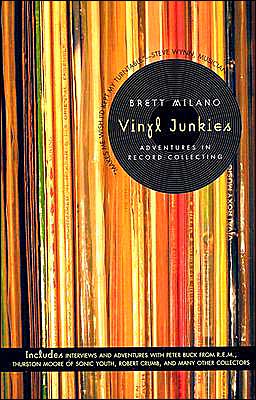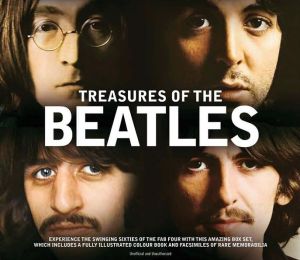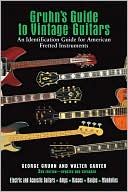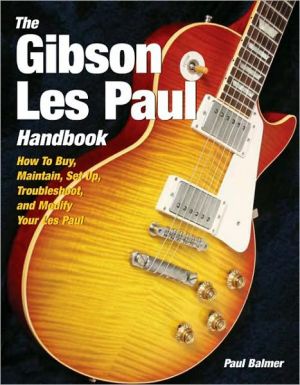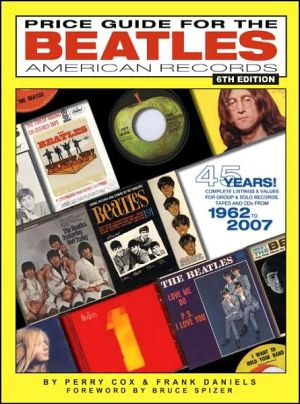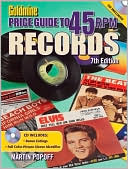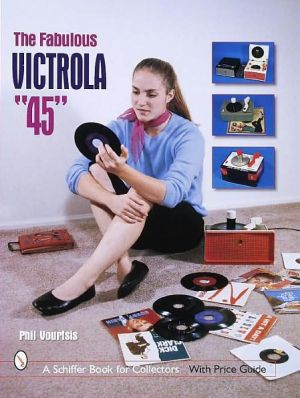Vinyl Junkies: Adventures in Record Collecting
Not too far away from the flea markets, dusty attics, cluttered used record stores and Ebay is the world of the vinyl junkies. Brett Milano dives deep into the piles of old vinyl to uncover the subculture of record collecting. A vinyl junkie is not the person who has a few old 45s shoved in the cuboard from their days in high school. Vinyl Junkies are the people who will travel over 3,000 miles to hear a rare b-side by a German band that has only recorded two songs since 1962, vinyl junkies...
Search in google:
Not too far away from the flea markets, dusty attics, cluttered used record stores and Ebay is the world of the vinyl junkies. Brett Milano dives deep into the piles of old vinyl to uncover the subculture of record collecting. A vinyl junkie is not the person who has a few old 45s shoved in the cuboard from their days in high school. Vinyl Junkies are the people who will travel over 3,000 miles to hear a rare b-side by a German band that has only recorded two songs since 1962, vinyl junkies are the people who own every copy of every record produced by the favorite artist from every pressing and printing in existance, vinyl junkies are the people who may just love that black plastic more than anything else in their lives. Brett Milano traveled the U.S. seeking out the most die-hard and fanatical collectors to capture all that it means to be a vinyl junkie. Includes interviews with Thurston Moore of Sonic Youth, Peter Buck from R.E.M and Robert Crumb, creator of Fritz the cat and many more underground comics.Library JournalAll subcultures claim to be misunderstood, and all subcultures have their rites of entrance that separate dabblers from doers. To be a true record collector, explains Milano, a Boston-based music journalist, it takes more than a Velvet Underground album and some volumes from the Nuggets compilations. "Love for the music, love for the artifact, the thrill of the chase" or a heroin Jones-like drive makes collectors accumulate thousands of little-known records and sometimes use bill money for the next score. High-profile vinyl junkies like Sonic Youth's Thurston Moore and underground comic guru Robert Crumb explain their obsession with the obscure. For some, like R.E.M.'s Peter Buck, a collection began with a crush on the record store clerk. Though Milano keeps the prose energetic through chapters on the psychiatric justification for hi-fi hoarding and on the world's truly bizarre records, those who busted open their Franklin Mint coin sets long ago to play some pinball may lose interest. Recommended for all libraries and other places using CDs for coasters.-Eric Hahn, West Des Moines, IA Copyright 2003 Reed Business Information.
Vinyl Junkies\ Adventures in Record Collecting \ \ By Brett Milano \ St. Martin's Griffin\ Copyright © 2003 Brett Milano\ All right reserved.\ ISBN: 9780312304270 \ \ \ Vinyl Junkies\ CHAPTER ONETHE SCYTHIAN"Give him the Scythian!" shouts Monoman from across the room. Pat waves his hand with a proper flourish: Nope, I'm not ready for the Scythian yet. We'll just have to build up to it.I'm sitting in a record-crowded apartment in the Boston suburbs, staring directly at a few hundred thousand dollars' worth of stereo equipment. Pat's stereo is nearly as eclectic as his record collection, which includes--just taking in the ones within eyesight--the Who, Doris Day, Tammy Wynette, Motorhead, Tom Jones, and Henry Mancini; this is a sensibility well beyond any standard notions of what's hip. The stereo is evidence of one man's quest for the perfect sound. The turntable is Pat's pick of the three dozen he's got in his house: suspendedon air and perfectly calibrated to be vibration-free, it's designed to make sure that no small disturbances--like, say, an earthquake or a nuclear detonation--interfere with the listening experience. The turntable was made by a stereo buff in New Hampshire, the tone arm came from Germany and cost another few grand. There are pillowcases stuffed into the corners of the ceiling to keep those precious soundwaves inside. Then there's the piece of wood."Don't forget that piece of wood," his assistant Jeff, a.k.a. Monoman, points out. Sure enough, it's a piece of wood: cut in the shape of a beehive with a hole in the middle, it screws on top of the center hole to make sure those dreaded vibrations don't get through--according to Jeff, "The only good vibrations come from the Beach Boys." The piece of wood cost a grand on its own, but as Pat assures us, "It's a really good piece of wood." \ \ I'd already had some of my best record-listening experiences on the crummiest stereos ever made. Stereo isn't even quite the right term--that thing I owned as a kid was more accurately a record player, a phonograph, maybe even a Victrola, but I believe the technical term we're looking for is "piece of crap": there was exactly one speaker, approximately the size of that little "O" you'd make if you closed your thumb and forefinger; and the needle tracked at something like two pounds, enough to cause instant damage to every record it touched. But it did go impossibly loud, and for ears trained on '60s AM radio, that was enough. The first record I rememberplaying on it was "She Loves You" by the Beatles, and it came out with that AM-radio sound: those harmonies at the start of the song sounded like a jet taking off. Which, culturally speaking, is exactly what they were. And when I later heard the same song under more desirable circumstances--on vinyl on a proper system; then on the CD reissue--it never had that compressed, unnatural sound that I always took for part of the recording.By the time I was thirteen, I owned what I thought was a luxury stereo. It was made by Magnavox, just like my parents' TV set. The speakers folded out, and the little turntable could be closed up into the player; it was a "portable" stereo that weighed close to fifty pounds. Unlike my childhood monstrosity, this one didn't ruin your records until the second or third play. You also had the option of ruining your records instantly by stacking them on the changer, where they'd be scraped by the changer-holder on top and by other records on the bottom. By now my musical tastes had become more refined, or so I thought at the time--Iwas deeply into Yes, Genesis, and their progressive-rock brethren. I'm still willing to argue till closing time about those bands' musical merits, but one thing is certain: their albums were incredibly detailed, full of sonic textures and mellotron overdubs--exactly what my introverted teenage ears were looking for. At this point, records weren't something I played over dinner or with company: I wanted to experience all those deep, layered sounds. Armed with my Magnavox power station and a pair of weighty headphones that made your ears throb after the first album side, I listened intently enough to catch them all. \ \ But now I'm hoping to get my mind blown in Brookline, to get the high-velocity sound I dreamed of back in my old bedroom. My guides for this trip are well known in the loose-knit community of Northeast collectors. Pat runs Looney Tunes, a used-record store that sits within the high-rent vicinity of the Berklee College of Music. The place's very existence looks like a slap at Starbuck's, Barnes & Noble, and the other upscale, uniform chains that fill up the same block. But there are enough Berklee-ites who are glad to snap up the vintage jazz and soul vinyl that clutters up the place--though they'd probably be a little spooked if they knew that their record's previous owner is likely as not to be six feet under. More than once has the widow of a collector made a call to Pat and his pickup truck; his unofficial motto is "You die, we buy." Sometimes the collections survive, but the marriage dies. Pat's been there when disgruntled wives have hit their husbands with the dreaded line, "It's me or the records." That's the cue for the husband to make his stand in front of the turntable, the wife to storm out, and Pat to go home empty-handed.Big and gregarious, with a Southern accent that he's maintained through decades in the Northeast, Pat was drinking martinis and name-dropping the Rat Pack before it became a trend. "This is obviously the house of somebody with a problem," he notes, surveying the unfiled discs that take up every bit of floor and shelf space. But unlike the stereotypical record collector--the hyper-geeky type most recently seen in a dark attic in the film Ghost World--Pat doesn't shut himselfaway with his vinyl. He has girlfriends, eats barbeque, and has used record-collecting as an excuse to travel. For him, collecting is an intrinsic part of the good life. He's fond of quoting the line "Music frees your mind from the tyranny of conscious thought."Monoman is unkempt, eccentric, and the leader of the best rock 'n' roll band I've ever seen. The long-standing nickname refers both to his love of monaural sound and to his relentless single-rnindedness. The name has changed spellings over the years: On a 1978 album with his first band, DMZ, he was Mono Mann. More recently, he fell in love with Japanese cartoons and briefly re-christened himself Pokemonoman. His current band, the Lyres, has been together twenty-two years and shows no signs of either slowing down or changing in the slightest degree. They take their cue from '6os garage punk, the three-chord stomp that was invented by countless teens who took "Louie Louie" as their gospel. In fact, Jeff learned many Lyres's songs by scouring the globe for obscure '60s singles, paying up to a grand for an original 45. But I'd doubt that a lot of those teenage '60s bands, hormone-driven though they were, could ever match this one on an especially hot or especially drunk night. He has destroyed instruments and friendships onstage: once he fired the drummer in the middle of the show (the drummer then got pissed off enough to play the set of his life). But he's just as likely to hit you with something truly soulful; the signature Lyres song, "Don't Give It Up Now," has gotten me through more than one crisis of faith. I once saw him earnestly explain to an audience that he wasn't in it for the money: "That's why we're playingthis crappy club for all of you cheap assholes!" There's been times when you'd swear that he's bypassed the tyranny of conscious thought altogether. \ \ Today Pat's commandeered the turntable while Monoman is sinking into a couch, welcoming the chance to blow off his part-time gig cataloging records for Pat's shop. The first thing he has in store is a Doris Day record. "Why that one?" I ask. "Because it was on top of the pile, and I like it," Pat explains. First he makes sure I'm positioned in the "sweet spot," where all eight of the speakers are facing me in equal proportions. Then he advises me to lean back and keep my eyes closed. Finally he sets the needle down, making sure not to turn the volume up until it's landed. And I sit back waiting to hear the heavens open.Instead, all I hear is Doris Day. On this particular record--a 1962 set with Andre Previn and his jazz trio--she does sound more sultry than her wholesome legend would have it. Between her alleged sexuality and the suggestive winks in a few of her hits, she could have been the Madonna of her time--go on, give "Teacher's Pet" and "Pillow Talk" another listen. Still, I'm getting no great revelations from this disc, other than that forty years of scratches add up to a whole lot of surface noise. When the drummer kicks in, it does sound as if the drumset was right there in the room. But as someone who sees live music a few times a week, I've been in enough real rooms with real drumsets that it's no big deal. And sorry,but neither is Doris Day. She may be close to sultry and modern on this record, but not quite close enough. So far I'm not impressed.Neither is Monoman, who only looks up from his magazine long enough to note that "It's good to listen to things that aren't rock. That just makes the rock sound so much better." Like many rock-eared collectors, the three of us grew up at the mercy of our parents' musical tastes. Fortunately, mine were savvy enough to slip in the occasional gem like Ravel's "Bolero," whose primal rhythms would be the first that spoke to me--even now I'm impressed that I was able to sit through fifteen minutes of it at such a young age. For Monoman, it was show tunes: he first got the beat in "76 Trombones." From there it was '60s AM radio. "I loved the Dave Clark Five because they had the organ," he recalls. "I had a fit when I was five because I didn't get an organ for Christmas. So I ruined Christmas for everybody, and I damn well got a piano next year."So if Doris Day can't open my ears, maybe some of that '60s music can. Pat first pulls out a cult classic, The Turtles Present the Battle of the Bands, and picks out the track called "I'm Chief Kamanawanalea." Yep, that one sure brings back memories of how much fun it was to shout the title at high school parties. (You can get the joke by saying "Kamanawanalea" out loud, but it's truly not worth it.) Not quite the stuff of audio nirvana, however. Okay, Pat goes for the heavy artillery: a pristine copy of the mono edition of the Beatles's Sgt. Pepper's Lonely Hearts Club Band. He carefully slides thedisc--with the original, sleek black U.K. Parlophone label--out of the jacket and cues up, of all things, "She's Leaving Home."Not that one, I plead, I hate that song. "Wait till you hear it in mono," he promises. "Just check out the Lennon harmonies." Nope, still hate it. But at least I've just learned why some vinyl diehards are sticklers for mono sound: with a good mono mix, the music sounds complete, as if it's all being pumped from the same heart. And John's chorus counterpoints are indeed louder in this version, always a plus. None of which is enough to keep this tearjerker of Paul's from being one of the small handful of Beatles songs that I just can't deal with.Mono Beatles albums have a cachet in the collector's market, in part because they're so scarce--stereo was no longer just a luxury item by the time the Beatles split up- and, because at this point, any newly-mined variation on a Beatles record is to be treasured. In the case of Sgt. Pepper, there are certain vocal bits--like a spoken rant by Paul right before "A Day in the Life"--that got mixed into oblivion on the stereo version. Beyond the collector's value, vinyl junkies detect a richness and warmth in mono records of this era, something to bring you closer to the sound of the period, to hearing the record in its original context. For a time Monoman refused to listen to anything else, and he still spends an inordinate amount of time and money questing for original editions of '60s singles, and he won't allow his Lyres to perform a '60s song unless an original copy is sitting in his collection. Mostrecently a European dealer sent him a tape of a little-known single and he fired back three hundred dollars for it--even though the music itself was already there on the tape. But it's about something more than just hearing a song: "Those original pressings are what you need to bring you closer to the original event."So are collectors just looking for a great musical experience like everyone else, though maybe with more fervor? Not quite. Because there's an element of fetishism in this as well, and it gets unleashed when Pat pulls out that vintage Pepper. Ninety percent of the people in the world would register an album cover they've seen a million times and move on. Not the case here: the picture may be the same, but the plastic lamination is different. "Whoa!" Monoman leaps from his chair. "I've never seen that one before." "Pretty unusual, isn't it?" Pat says. "The cover doesn't feel as heavily embossed as usual." Here's where we get into the deep details. Old Bob Dylan records, for example, have distinguishing marks on the labels. You can spot a first pressing by an indent around the edge of the label itself (and collectors swear you'll be rewarded with a better-sounding copy). The date of this Pepper is more elusive: maybe in the '70s, when some new cardboard stock came into the pressing plants? But doesn't the record itself sound closer to that desirable first pressing? The mystery isn't about to get solved, and the original owner isn't around to clear it up. When you start wondering about the personal history of a disc you've just acquired, you're getting close to the point of no return. \ \ Time is wasting, however, and I still haven't had my mind blown. "Give him the Scythian!" Monoman yells. Not quite. Pat has one more trick up his sleeve. This time it's Louis Armstrong. The disc is Satchmo Plays King Oliver, a 1962 release on the Audio Fidelity label. It's theoretically from the dark ages, when stereo recording was still in its infancy. But damn, now we're talking revelation. Every note on this thing is beautifully vivid, and it doesn't hurt that the music (the New Orleans standard "St. James Infirmary") is stellar. My memories of a lesser Louis Armstrong doing "Hello Dolly" or the sentimental "What a Wonderful World" (a song I'd rank down there with "She's Leaving Home") are melting away by the minute. And here I'm learning one of the secrets: that good stereo sound is a psychedelic experience. I'm not just seeing Satchmo's horn, I'm seeing the shape of the notes and the color of the sound. When he sings, I'm looking deep down into his throat while the drums and bass push me from behind. So now I understand why a lot of record collectors don't do drugs--when they crank that stereo up, they're already doing one.Every vinyl junkie has a moment like this, when the sound hits you between the eyes and you're hooked for life. Pat got the rush when "Be My Baby" by the Ronettes was blaring from a car radio. Producer Phil Spector made that record to be overwhelming--with its massive drums and heavenly choir--and in Pat's case (and that of the Beach Boys's Brian Wilson, who also loved the record) it did the trick. As for Monoman, he gets reinitiated every time he discovers a new medium. Lately hisdrug of choice is reel-to-reel tapes, the ones that were issued in the '60s and only played in high-class bachelor pads. "It's the Hugh Hefner thing. Those tapes were the high-end item, the compact disc of their day. The goal is to get as close to the master tape as possible. That's where the reel tapes bring me, and the turntable is another path."It's getting late, however, and though Louis Armstrong started me down the path, I've still got a foot in the real world. So now it's time to pull out the heavy artillery, as they prepare to give me the Scythian. That would be the "Scythian Suite" by Prokofiev, but not just any copy. This is the 1957 recording by Antal Dorati and the London Symphony Orchestra on the Mercury label--one of the first stereo recordings ever issued. The legend "Mercury Living Presence" blazes proudly across the cover; the same design is still there on the current compact-disc edition. But we're looking to get close to the master tape and deep into the music, and the preferred path is that original 1957 pressing, made while the master tape was likely still throbbing. Pat produces the item from the middle of a stack, in a dark corner of his collection. "Is that a real one?" asks Monoman, raising his eyes. Pat nods his head with proper gravity. This is starting to look like the glow-box scene from Pulp Fiction--hell, maybe a pristine copy of the "Scythian Suite" was the box's mysterious contents."Just feel how round that edge is," notes Pat, running a finger around the LP's circumference. "Yeah, it's the real deal," Monoman nods. The glossy laminated cover is also studied, and the disc's runout groove is inspected for the distinguishing mark: the letter "I" stamped into a small circle.That stands for Indianapolis, which means the record was stamped at that city's RCA plant--in other words the record is like any good fix, clean and uncut by cheap additives. As Pat bears it to the turntable, Monoman gives the music some perspective: "Those Scythians, man, they were fuckin' pagans! Human sacrifices, you name it." I have been warned.Maybe Pat's discreetly jacked up the bass and treble, maybe he's slipped something in my tea. In any case, the Scythian starts and all hell breaks loose. A big unearthly screech--that's the strings making fire-and-brimstone noises. A roll of thunder from dangerously close--that's the orchestral bass drums. "AAAH! We're all gonna fuckin' die!"--that's Monoman feeling the spirit, running around the room with hair shaking and shirttail flying. If Prokofiev wasn't aiming for exactly that response, I'm sure that whoever engineered the record was. The roller-coaster construction of the piece only helps the effect: there are a few moments of deceptive calm before the thunder starts up again, this time with added gongs. "That's it, that's heavy metal!" is Monoman's reaction, his shouts becoming a perfectly fitting vocal part. "Hey, Led Zeppelin--you suck!"This is where the addiction starts: when the music and the sound get so beautifully overwhelming that you wouldn't mind devoting a chunk of your life to more of the same. For now, the purple vacuum tubes are starting to calm down, and any more music would be overkill. Pat can take pride in making another convert, and Monoman can come down off his vinyl high. "The Scythian, man. Can't get enough of it."Copyright © 2003 by Brett Milano. All rights reserved. \ \ Continues... \ \ \ \ Excerpted from Vinyl Junkies by Brett Milano Copyright © 2003 by Brett Milano. Excerpted by permission.\ All rights reserved. No part of this excerpt may be reproduced or reprinted without permission in writing from the publisher.\ Excerpts are provided by Dial-A-Book Inc. solely for the personal use of visitors to this web site. \ \
Acknowledgments1The Scythian12Why We Collect133It's a Serotonin Thing294The Lure of Vinyl355On the Road I: Relics in Texas516Behind the Counter with Peter Buck597Robert Crumb: "Collecting is Creepy!"698On the Road 2: Soul Heart Transplant779Valley of the Strange9510Our Favorite Shops11511Love and Vinyl13112Geekery in the U.K.14713Extreme Collecting16314The Ultimate Find17915The Soundtrack of Your Life19716Bonus Track215Index221
\ Library JournalAll subcultures claim to be misunderstood, and all subcultures have their rites of entrance that separate dabblers from doers. To be a true record collector, explains Milano, a Boston-based music journalist, it takes more than a Velvet Underground album and some volumes from the Nuggets compilations. "Love for the music, love for the artifact, the thrill of the chase" or a heroin Jones-like drive makes collectors accumulate thousands of little-known records and sometimes use bill money for the next score. High-profile vinyl junkies like Sonic Youth's Thurston Moore and underground comic guru Robert Crumb explain their obsession with the obscure. For some, like R.E.M.'s Peter Buck, a collection began with a crush on the record store clerk. Though Milano keeps the prose energetic through chapters on the psychiatric justification for hi-fi hoarding and on the world's truly bizarre records, those who busted open their Franklin Mint coin sets long ago to play some pinball may lose interest. Recommended for all libraries and other places using CDs for coasters.-Eric Hahn, West Des Moines, IA Copyright 2003 Reed Business Information.\ \
